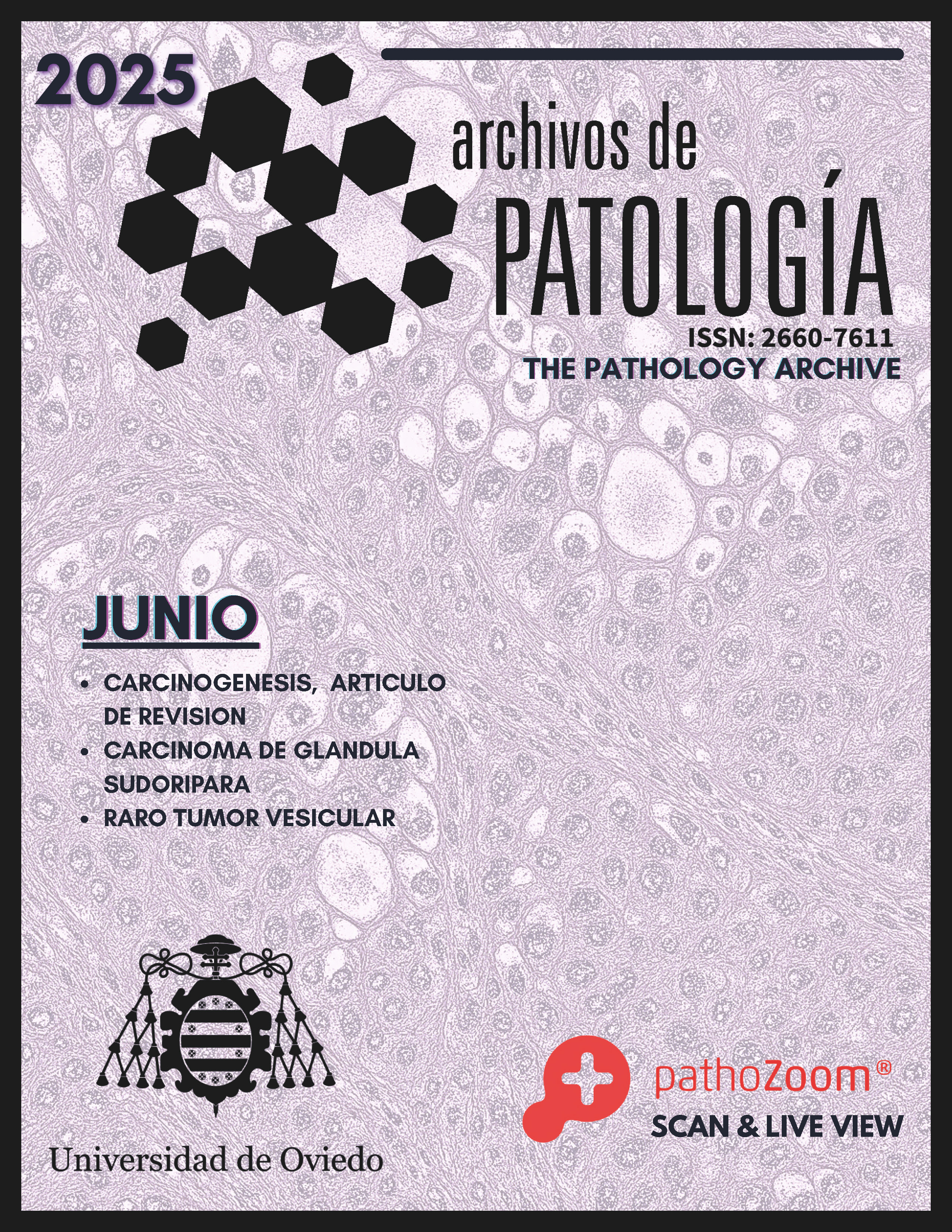Resumen
El cáncer es una enfermedad de alta carga mundial, caracterizada por el crecimiento descontrolado de células con capacidad de invasión y metástasis. Su origen se relaciona con alteraciones genéticas y epigenéticas que afectan el equilibrio entre protooncogenes y genes supresores de tumores, lo que permite la proliferación celular autónoma y la evolución clonal hacia fenotipos más agresivos. Durante este proceso, las células adquieren propiedades conocidas como los rasgos distintivos del cáncer, que explican su progresión y resistencia terapéutica.
La patología es la disciplina central en el diagnóstico oncológico. A través de la evaluación histológica, citológica, inmunohistoquímica y molecular, permite establecer el tipo tumoral, su grado de diferenciación, invasividad y características con potencial terapéutico. Herramientas como la inmunohistoquímica, la secuenciación genómica y la biopsia líquida han ampliado las posibilidades diagnósticas, pronósticas y de terapéuticas personalizadas.
Los tumores se clasifican según su estirpe celular y comportamiento biológico en benignos o malignos. Los benignos presentan crecimiento lento, están bien delimitados y no metastatizan. Los malignos, por el contrario, muestran anaplasia, invasión local y diseminación a distancia. El conocimiento de términos clave como diferenciación, displasia, carcinoma in situ, invasión y metástasis es fundamental para interpretar adecuadamente los hallazgos patológicos.
Desde el enfoque clínico, el médico general desempeña un papel clave en la detección precoz, la interpretación inicial de signos de alarma y la remisión oportuna. Además, debe comprender los fundamentos básicos de la oncología moderna para acompañar el proceso diagnóstico y terapéutico. Fortalecer estas competencias desde el primer nivel de atención es esencial para mejorar el acceso, la calidad del tratamiento y los desenlaces en salud de los pacientes con cáncer.
Citas
Hanahan D. Hallmarks of Cancer: New Dimensions. Cancer Discov. 2022;12(1):31-46. doi:10.1158/2159-8290.CD-21-1059
Kumar V, Abbas AK, Aster JC. Patología estructural y funcional de Robbins. 9.ª ed. Elsevier; 2024.
Goldblum JR, Lamps LW, McKenney JK. Rosai and Ackerman's Surgical Pathology. 11th ed. 2 vols. Philadelphia: Elsevier; 2017. ISBN: 9780323263399.
WHO Classification of Tumours Editorial Board. WHO Classification of Tumours Online. Lyon: International Agency for Research on Cancer; 2022. Disponible en: https://tumourclassification.iarc.who.int/
International Agency for Research on Cancer. Global Cancer Observatory. Lyon: World Health Organization; 2022. Disponible en: https://gco.iarc.fr/en
Cuenta de Alto Costo. Día Mundial de la Lucha contra el Cáncer de Mama 2023 [Internet]. Bogotá: Cuenta de Alto Costo; 2023. Disponible en: https://cuentadealtocosto.org/cancer/dia-mundial-de-la-lucha-contra-el-cancer-de-mama-2023.
McPherson RA, Pincus MR. Henry's Clinical Diagnosis and Management by Laboratory Methods. 24th ed. Philadelphia: Elsevier; 2021. ISBN: 9780323673204.
Kiri S, Ryba T. Cancer, metastasis, and the epigenome. Mol Cancer. 2024;23(1):154. Published 2024 Aug 2. doi:10.1186/s12943-024-02069-w
Sung H, Ferlay J, Siegel RL, et al. Global Cancer Statistics 2020: GLOBOCAN Estimates of Incidence and Mortality Worldwide for 36 Cancers in 185 Countries. CA Cancer J Clin. 2021;71(3):209-249. doi:10.3322/caac.21660
Bray F, Laversanne M, Weiderpass E, Soerjomataram I. The ever-increasing importance of cancer as a leading cause of premature death worldwide. Cancer. 2021;127(16):3029-3030. doi:10.1002/cncr.33587
Bertram JS. The molecular biology of cancer. Mol Aspects Med. 2000;21(6):167-223. doi:10.1016/s0098-2997(00)00007-8
Fearon ER, Vogelstein B. A genetic model for colorectal tumorigenesis. Cell. 1990;61(5):759-767. doi:10.1016/0092-8674(90)90186-i
Vogelstein B, Papadopoulos N, Velculescu VE, Zhou S, Diaz LA Jr, Kinzler KW. Cancer genome landscapes. Science. 2013;339(6127):1546-1558. doi:10.1126/science.1235122
Stratton MR, Campbell PJ, Futreal PA. The cancer genome. Nature. 2009;458(7239):719-724. doi:10.1038/nature07943
Weinberg, R., & Cell, O. R. (2017). The Principles and Drivers of Cancer. The American Cancer Society's Principles of Oncology: Prevention to Survivorship, 139.
Ecsedy, J. E. F. F. R. E. Y., & Hunter, D. A. V. I. D. (2002). The origin of cancer. Textbook of cancer epidemiology, 3, 61-85.
Sobin LH, Gospodarowicz MK, Wittekind C. TNM Classification of Malignant Tumours. 8th ed. Wiley-Blackwell; 2017.
Amin MB, Greene FL, Edge SB, et al. The Eighth Edition AJCC Cancer Staging Manual: Continuing to build a bridge from a population-based to a more "personalized" approach to cancer staging. CA Cancer J Clin. 2017;67(2):93-99. doi:10.3322/caac.21388
Pineros M, Abriata MG, de Vries E, Barrios E, Bravo LE, Cueva P, et al. Progress, challenges and ways forward supporting cancer surveillance in Latin America. Int J Cancer 2021;149:12–20.
Greaves M. Evolutionary determinants of cancer. Cancer Discov. 2015;5(8):806-820. doi:10.1158/2159-8290.CD-15-0439
Gerlinger M, McGranahan N, Dewhurst SM, Burrell RA, Tomlinson I, Swanton C. Cancer: evolution within a lifetime. Annu Rev Genet. 2014;48:215-236. doi:10.1146/annurev-genet-120213-092314
Bremnes RM, Dønnem T, Al-Saad S, et al. The role of tumor stroma in cancer progression and prognosis: emphasis on carcinoma-associated fibroblasts and non-small cell lung cancer. J Thorac Oncol. 2011;6(1):209-217. doi:10.1097/JTO.0b013e3181f8a1bd
Siegel RL, Miller KD, Fuchs HE, Jemal A. Cancer statistics, 2022. CA Cancer J Clin 2022;72:7–33.
Schwartz SM. Epidemiology of Cancer. Clin Chem. 2024;70(1):140-149. doi:10.1093/clinchem/hvad202.
Moni ZA, Hasan Z, Alam MS, Roy N, Islam F. Diagnostic and Prognostic Significance of Exosomes and Their Components in Patients With Cancers. Cancer Med. 2025;14(1):e70569. doi:10.1002/cam4.70569

